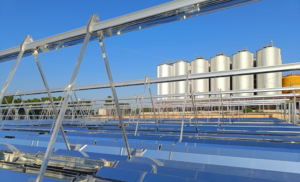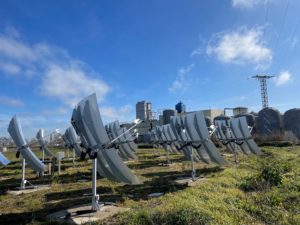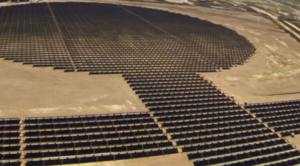

Portugal: Task 49 Develops Process Heat Integration Guidelines
In the middle of October, the members of the IEA SHC Task 49 on solar process heat met in Évora, Portugal, to discuss, among other things, the first version of the integration guidelines for solar process heat systems. They are part of the design guidelines – one of the main goals of the Task. According to Christoph Brunner, the Task’s members plan to publish the integration guidelines in early 2014 after an internal review. Brunner is Operating Agent of Task 49 and Head of the Department of Industrial Processes and Energy Systems at the Austrian institute AEE Intec.
The integration guidelines describe in detail how to incorporate solar heat into industrial processes. They include schematics and descriptions for the different hydraulic modules of a solar process heat system: the primary solar collector circuit, the secondary solar circuit to load the storage, the storage system, the process distribution system and the production process itself. The guidelines depict both generalised and common examples of hydraulic schemes. For instance, the document illustrates quasi-continuous water heating for cleaning processes by using the example of a bottle washer. Of course, the use of this type of hydraulic is not limited to cleaning bottles, but can apply to other processes with similar requirements. The integration guidelines also contain descriptions of pressurised and non-pressurised storage systems.
The modular design allows planners to combine the most suitable ideas. A decision guideline for choosing the best integration strategy is under review and will be published later, Brunner says.
Another topic of the meeting was the first version of the SOCO software developed by AEE Intec. SOCO can perform pinch analyses as described in the former IEA SHC Task 33 Solar Heat for Industrial Processes (SHIP)’ to make industrial processes more efficient, as well as better suitable for solar heat.
The software allows a manufacturing company to design a heat exchanger network while considering temporary fluctuations in the energy demand of different processes. The tool also offers an option to design, simulate and optimise hot water storage tanks. “It represents the process side of the plant. You will need an additional solar thermal simulation tool to design the solar system,” Brunner says. The simulation tool can be a commercially available programme, such as Polysun or T*Sol. The first version of SOCO has now been delivered to the project partners for testing and evaluation. So far, Brunner has not been able to pinpoint how and when it will be available for planners outside the Task.
The database of solar process heat systems worldwide, which was developed by AEE Intec and PSE, is close to being published as well. At the moment, it contains 122 plants and is scheduled to go online in January 2014. Project data usually includes size, location and type of the process. In some cases, economic and performance data is available, too.
The database originates from a Task 49 survey carried out by AEE Intec in 2013. The authors of the survey collected data on 122 plants with a total thermal output of 87.8 MW and a total collector area of more than 125,600 m². With 71 plants in operation, Europe was clearly the main market, followed by Asia with 21 plants. The food and beverage industry accounted for about 35,000 m² of the surveyed projects. The most important processes were cleaning (24 plants), drying (19 plants) and supplying boiler water (16 plants). 59 systems used flat plate collectors, followed by vacuum tubes (23 plants) and air collectors (16 plants). System costs varied greatly, starting from little more than 100 EUR/m² to more than 700 EUR/m² for flat plate collector systems and reaching from little more than 500 EUR/m² to almost 1,200 EUR/m² for vacuum collector systems. Sorted by system size, it turns out that the greatest cost ratio for large systems over 1,000 m² collector area – 300 EUR/m² – was less than for smaller systems. For more information, see the attached presentation held at the International Conference on Solar Heating and Cooling in Freiburg, Germany, in September (this article contains an updated plant figure).
The IEA SHC Task 49 started in January 2012 and is scheduled to run until the end of 2015. It is a joint task that is simultaneously listed as IEA Solarpaces Task IV, which allows for the cooperation with the Solarpaces programme for concentrating high-temperature solar systems.
More information:
About IEA SHC Task 49: http://task49.iea-shc.org


